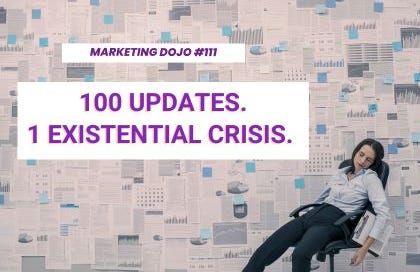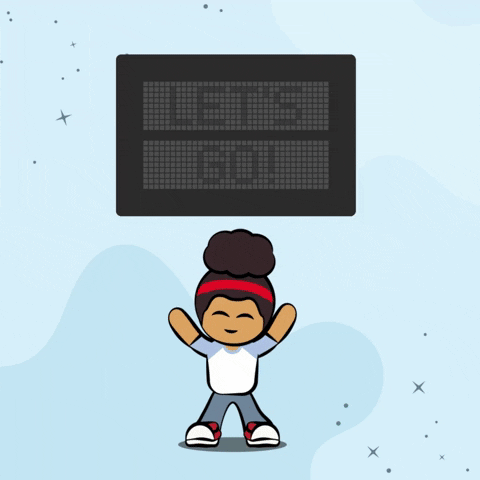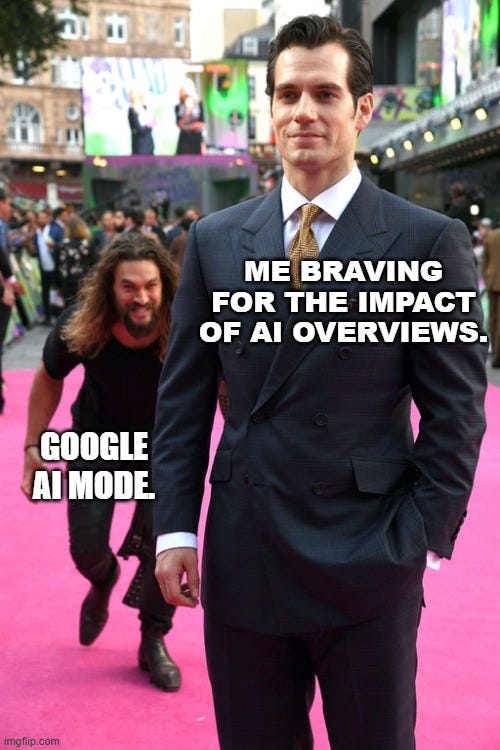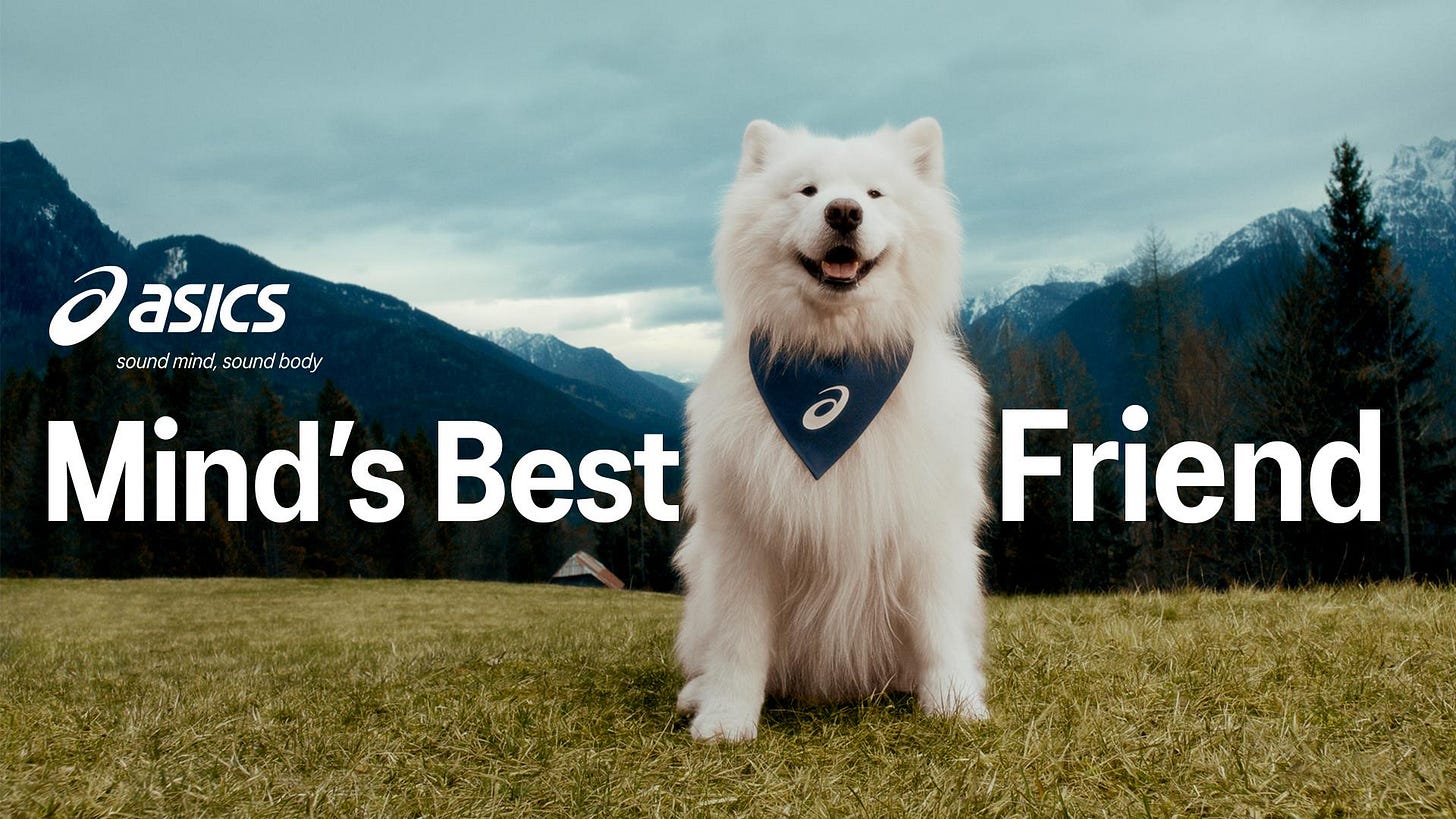MarketingDojo #111: 🤯100 Updates. 1 Existential Crisis.📉
Google has no chill, Dog influencers will sell shoes and all you need for your AI Chatbot strategy.
There’s probably a word for it.
That odd mix of exhaustion and anticipation when your to-do list is overflowing, but a holiday is just around the corner.
It’s almost June. And for me, that means my first real break of the year.
Marketing Dojo is taking a pause. There will be no issues for the next three weeks. I’ll be back at the end of June with a rested brain and fewer browser tabs open.
But before I go, here’s Issue #111 of The Marketing Dojo.
In today’s edition:
⚡ Google’s awe and shock move: What I/O means for marketers
🐶 ASICS: A new class of influencers
🤖 A framework to implement AI chatbots
And a few more gems worth your scroll
Let’s dive in.
Meme-Time: The AI Tsunami.
"There are decades where nothing happens and weeks where decades happen."
Last week felt like one of those "decade-type" weeks. If I had to sum up my emotions, it would look like this:
Anthropic released Claude 4.0. Microsoft announced more real-time "agentic AI" tools. OpenAI acquired AI hardware startup io, co-founded by former Apple designer Jony Ive, for $6.5 billion
And then there's Google. At I/O, it unveiled over 100 AI updates. I take some of these curated demos with a grain of salt. Half of them are not nearly as mind-blowing as they seem.
However, last week's changes are significant; they are already shaping how people discover products, evaluate options, and complete purchases.
There's a lot to unpack, but I will begin with 3 things from Google's I/O conference that shook up the marketer in me.
Google I/O Conference: The Marketer’s Version.
1. AI Mode: Google’s answer to ChatGPT
If AI Overviews felt like a shake-up, they were just the foreshocks. AI Mode is the actual earthquake.
Unveiled at Google I/O, AI Mode is the company’s final goodbye to the traditional search. Instead of ten blue links and a list of snippets we usually experience while using Google search, it will now be fully synthesised and crafted into a succinct answer by Gemini 2.5.
The new model will be used to break down your complex query, search across the web in parallel, and then assemble a detailed response—all within a single scroll.
We’ve already seen the early damage. AI Overviews slashed traffic to publishers by 30% or more, depending on the category. Websites that once relied on Google as a top referrer were adjusting to the new reality.
And AI Mode takes it a step further.
Google has begun rolling it out to U.S. users inside the main Search tab. This means AI mode will now be available in the most-used interface on the internet.
For marketers, it marks a fundamental shift: from being found through search… to being summarised by AI.
An important side-note: The AI mode is also centering around changing the shopping experience, eliminating the need to visit a brand’s website to browse and shop.
2. Project Mariner: Google’s AI agent.
2025 is truly the year of AI agents: tools that don’t just answer your queries but act on them. Google’s version of this is called Project Mariner, which is now available in Google Labs.
You tell it:
“Book me dinner near my hotel this Friday.”
“Find Arsenal tickets under $100.”
“Schedule a haircut before 3 PM.”
And then you go about your day. Mariner goes to work.
It searches. Compares. Fills out forms. Essentially handling your digital legwork.
For marketers selling digitally, this might mean a significant shift.
The discovery journey might skip traditional pages entirely. If Google’s agent can surface and complete a task before the user clicks anywhere, we’ll need to rethink how and where brands show up in those moments.
3. Video & Image Generation Tools: Veo3, Flow, Imagen.
At I/O, Google also unveiled its new AI-powered creative toolkit. Here's what stood out:
Veo 3 – Their next-gen video model can generate camera motion, background audio, and even character dialogue.
Google Flow – A filmmaking assistant that pulls from Veo, Imagen, and Gemini to build entire animated scenes from scratch. One line of text, and boom—you've got a storyboard.
Imagen 4 – The new image model delivers hyper-realistic visuals, faster and sharper than anything they've shipped before.
In short: Vibe marketers got a bag full of party tricks to show off.
Creative Excellence: Man’s Mind’s Best Friend.
After all the AI chaos, here’s something that made me smile.
ASICS has signed its first-ever dog influencer.
Meet Felix the Samoyed, a fluffy, globe-trotting canine with over a million Instagram followers. He’s now the face (and fur) of ASICS’ new campaign, Mind’s Best Friend.
The campaign is built on a simple insight:
65% of dog owners say their dog is their top motivator to get out and move. They’re more likely to hit the weekly activity target of 210 minutes and report better mental health, too.
So, instead of another fitness influencer or pro athlete, ASICS went with a dog that literally makes people move.
The campaign also has a community angle. Dog owners can nominate their pets as “Mind’s Best Friend” ambassadors. Winning pups get branded gear. Their humans get ASICS shoes.
It’s smart. It’s joyful. And it might just be the best use of influencer marketing I’ve seen this year.
A Primer on AI ChatBots (Courtesy Wharton).
From Target’s Store Companion to Amazon’s Rufus, AI chatbots are everywhere.
That’s why The Wharton Blueprint for Effective AI Chatbots is a timely resource. It outlines the human-AI combinations and the psychological nudges that make people more likely to trust chatbot interactions.
What stood out to me was their simple, four-scenario framework:
Use AI alone for repetitive, low-risk tasks (e.g. refund tracking, check-ins).
AI with light human supervision for regulated but scalable use cases (e-commerce, banking, healthcare admin).
Humans assisted by AI for complex decisions—insurance claims, financial advice, and medical consultations.
Humans only for high-trust, accuracy-critical settings (law, surgery prep, compliance-heavy calls).
If you’re mapping out chatbot roles in your business, this is a comprehensive study worth bookmarking.
Short Stuff:
Europe’s efforts to block social media for kids gather pace (Greece leads the effort, which now has the support from France and Spain).
Instagram is paying creators up to $20,000 for driving new signups & traffic (It’s raining money on IG creators).
Buy Now, pay later business Klarna declared massive losses and delayed the plan for IPO after all-time high defaults. (Buy now pay never generation).
That’s a wrap on this week. Thank you for your time and attention. If you made it this far and enjoyed what you read, remember to leave a like. I appreciate your support.
I will see you in your inbox in a few short weeks.
Regards,
Garima








